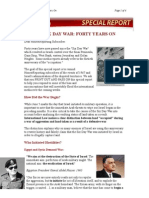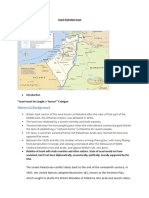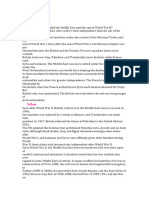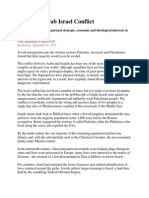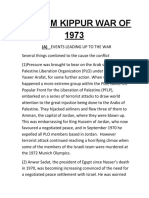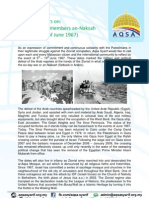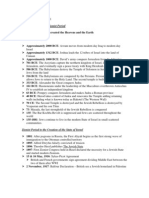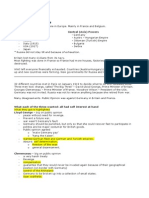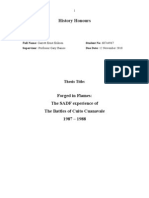Case Study
Case Study
Uploaded by
Sakshi BansalCopyright:
Available Formats
Case Study
Case Study
Uploaded by
Sakshi BansalOriginal Title
Copyright
Available Formats
Share this document
Did you find this document useful?
Is this content inappropriate?
Copyright:
Available Formats
Case Study
Case Study
Uploaded by
Sakshi BansalCopyright:
Available Formats
CASE STUDY BUSINESS COMMUNICATION 1967- Israeli-Egyptian conflict. After Israel Captured Sinai , Egypt demanded immediate withdrawal.
l. Israel refused to withdrawal, fearing a natural security crisis.
QUESTIONSQ1). What were the underlying issues? Ans. The June 1967 War was a watershed event in the history of Israel and the Middle East. After only six days of fighting, Israel had radically altered the political map of the region. By June 13, Israeli forces had captured the Golan Heights from Syria, Sinai and the Gaza Strip from Egypt and the West Bank from Jordan. The new territories more than doubled the size of pre1967 Israel, placing under Israel's control more than 1 million Palestinian Arabs. In Israel, the ease of the victory, the expansion of the state's territory, and the reuniting of Jerusalem, the holiest place in Judaism, permanently altered political discourse. In the Arab camp, the war significantly weakened Nasserism, and led to the emergence of the Palestine Liberation Organization (PLO) as the leading representative of the Palestinian people and effective player in Arab politics.
Q2). How was the conflict resolved? Ans. Following the June 1967 War, the PLO established in Jordan its major base of operations for the war against Israel. Throughout the late 1960s, a cycle of Palestinian guerrilla attacks followed by Israeli retaliatory raids against Jordan caused much damage to Jordan. In September 1970, after militant factions of the PLO (who previously had stated that "the road to Tel Aviv lies through Amman") hijacked four foreign planes and forced them to land in Jordan, King Hussein decided it was time to act. Throughout September the Jordanian military launched an attack to push the PLO out of Jordan. Jordan's attack on the PLO led to an escalation of SyrianIsraeli tensions. It was widely believed in Washington that deployment of Israeli troops along the Jordan River had deterred a large-scale Syrian invasion of Jordan. As a result, President Richard M. Nixon increasingly viewed Israel as an important strategic asset, and the Rogers Plan was allowed to die. While negotiating a cease-fire to the conflict in Jordan, Nasser died of a heart attack. The new Egyptian president, Anwar as Sadat, quickly realized, just as Nasser had toward the end of his life, that Egypt's acute economic and social problems were more pressing than the conflict with
Israel. Sadat believed that by making peace with Israel Egypt could reduce its huge defense burden and obtain desperately needed American financial assistance. He realized, however, that before some type of arrangement with Israel could be reached, Egypt would have to regain the territory lost to Israel in the June 1967 War. To achieve these ends, Sadat launched a diplomatic initiative as early as 1971, aimed at exchanging territory for peace. On February 4, 1971, he told the Egyptian parliament: that if Israel withdrew her forces in Sinai to the passes I would be willing to reopen the Suez Canal; to have my forces cross to the East Bank . . . to make a solemn declaration of a cease-fire; to restore diplomatic relations with the United States and to sign a peace agreement with Israel through the efforts of Dr. Jarring, the representative of the Secretary General of the United Nations. Sadat's peace initiative, similar to the Rogers Plan, was not warmly received in Israel. Prime Minister Golda Meir stated unequivocally that Israel would never return to the prewar borders. She also commissioned the establishment of a settlement on occupied Egyptian territory at Yamit, near the Gaza Strip. Her rejection of the Egyptian offer reflected the hawkish but also complacent politico-military strategy that had guided Israeli policy after the June 1967 War. Advised by Minister of Defense General Moshe Dayan and ambassador to Washington General Yitzhak Rabin, the Meir government held that the IDF's preponderance of power, the disarray of the Arab world, and the large buffer provided by Sinai, the West Bank, and the Golan Heights would deter the Arab states from launching an attack against Israel. Therefore, the Israeli government perceived no compelling reason to trade territory for peace. This view had wide Israeli public support as a result of a growing settler movement in the occupied territories, a spate of Arab terrorist attacks that hardened public opinion against compromise with the Arabs, and the widespread feeling that the Arab states were incapable of launching a successful attack on Israel. Israel's complacency concerning an Arab attack was bolstered in July 1972 by Sadat's surprise announcement that he was expelling most Soviet military advisers.
Q3). Which side won the resolution? Ans. The actual fighting was over almost before it began; the Israeli Air Corps on June 5 destroyed nearly the entire Egyptian Air Force on the ground. King Hussein of Jordan, misinformed by Nasser about Egyptian losses, authorized Jordanian artillery to fire on Jerusalem. Subsequently, both the Jordanians in the east and the Syrians in the north were quickly defeated. In the midst of the nationalist euphoria that followed the war, talk of exchanging newly captured territories for peace had little public appeal. The Eshkol government followed a two-track policy with respect to the territories, which would be continued under future Labor governments: on the one hand, it stated a willingness to negotiate, while on the other, it laid plans to create Jewish settlements in the disputed territories. Thus, immediately following the war, Eshkol issued a statement that he was willing to negotiate "everything" for a full peace, which would include free
passage through the Suez Canal and the Strait of Tiran and a solution to the refugee problem in the context of regional cooperation. This was followed in November 1967 by his acceptance of UN Security Council Resolution 242, which called for "withdrawal of Israeli armed forces from territories occupied in the recent conflict" in exchange for Arab acceptance of Israel. Concurrently, on September 24, Eshkol's government announced plans for the resettlement of the Old City of Jerusalem, of the Etzion Bloc-- kibbutzim on the Bethlehem-Hebron road wiped out by Palestinians in the war of 1948--and for kibbutzim in the northern sector of the Golan Heights. Plans were also unveiled for new neighborhoods around Jerusalem, near the old buildings of Hebrew University, and near the Hadassah Hospital on Mount Scopus.
Submitted byHimanshu bansal(27)
You might also like
- Constructivism in The Context of Six Days' War, 1967Document5 pagesConstructivism in The Context of Six Days' War, 1967Jahanzaib KhanNo ratings yet
- Iran-Iraq WarDocument56 pagesIran-Iraq Warveca12350% (2)
- Ne Chronic ADocument246 pagesNe Chronic ADontrell Hall0% (1)
- Fmi 3-90.5Document790 pagesFmi 3-90.5intense4dislikeNo ratings yet
- Arab Israeli War of 1967: SyriaDocument11 pagesArab Israeli War of 1967: Syriaمسٹر بلوچNo ratings yet
- State The Conditions For TheDocument11 pagesState The Conditions For Theمسٹر بلوچNo ratings yet
- Promises TimelineDocument10 pagesPromises Timelineapi-287737671No ratings yet
- Item M: Faces in The Timeline-A Brief History of The Israeli-Palestinian ConflictDocument4 pagesItem M: Faces in The Timeline-A Brief History of The Israeli-Palestinian ConflictParents for Excellence in Newton Schools (PENS)No ratings yet
- Assignment MEDocument3 pagesAssignment MEAyesha QhNo ratings yet
- 6 Day WarDocument6 pages6 Day Warlambert100% (1)
- Israel-Palestine IssueDocument3 pagesIsrael-Palestine IssueasfandyaralighunioNo ratings yet
- Six Days WarDocument45 pagesSix Days WarZoltan NagyNo ratings yet
- Arab Israeli 1948-1996Document9 pagesArab Israeli 1948-1996Darksoulja1 GreatestNo ratings yet
- The David Project 1967 Six Day War April 2010Document6 pagesThe David Project 1967 Six Day War April 2010Aya K SuleimanNo ratings yet
- WCP Unit 3Document8 pagesWCP Unit 3santhoshraja vNo ratings yet
- IsraelDocument18 pagesIsraelJayesh PatelNo ratings yet
- Study Guide 3Document8 pagesStudy Guide 3Roman PableNo ratings yet
- Israel-Palestine Conflict (An Apple of Discord in Middle East)Document7 pagesIsrael-Palestine Conflict (An Apple of Discord in Middle East)Malick Sajid Ali IlladiiNo ratings yet
- Settlements Primer and Discussion Guide Final VersionDocument17 pagesSettlements Primer and Discussion Guide Final VersionEldad TzioniNo ratings yet
- In The Crosshairs - Examining Israel's Impact On The Palestine Conflict - KHI Kastrat 2024 - Emil Fadhlan AntaredjaDocument13 pagesIn The Crosshairs - Examining Israel's Impact On The Palestine Conflict - KHI Kastrat 2024 - Emil Fadhlan AntaredjaEmil FadhjaNo ratings yet
- Thesis For Arab Israeli ConflictDocument7 pagesThesis For Arab Israeli Conflictjenniferlandsmannneworleans100% (2)
- The Middle East Study NotesDocument7 pagesThe Middle East Study NotesDKNYMileyNo ratings yet
- Israel Palestine ConflictDocument27 pagesIsrael Palestine ConflictMohsin JavedNo ratings yet
- Preventing Palestine: A Political History from Camp David to OsloFrom EverandPreventing Palestine: A Political History from Camp David to OsloNo ratings yet
- Annexation of The West Bank of Jordan: Israel and The Occupied Palestinian TerritoriesDocument2 pagesAnnexation of The West Bank of Jordan: Israel and The Occupied Palestinian Territoriesmuhammad ismailNo ratings yet
- 412 AssignmentDocument14 pages412 Assignmentigbinore sylvesterNo ratings yet
- Israeli LeadersDocument2 pagesIsraeli LeadersYiyao ZhangNo ratings yet
- Palestine IssueDocument5 pagesPalestine Issuesikandar waqarNo ratings yet
- SixdaywarDocument30 pagesSixdaywarJose machado100% (1)
- The Realignment of The Middle EastDocument21 pagesThe Realignment of The Middle Eastsyeduop3510No ratings yet
- 1968 4 ArabisraelwarDocument117 pages1968 4 ArabisraelwarpcojediNo ratings yet
- The Truth Behind The Arab-Israeli WarDocument5 pagesThe Truth Behind The Arab-Israeli Warmarcia4sato100% (1)
- ArabDocument10 pagesArabdr7dh8c2sdNo ratings yet
- Arab Israeli - Conflict 1Document27 pagesArab Israeli - Conflict 1Yogesh PatelNo ratings yet
- Ghaza Strip - HistoryDocument5 pagesGhaza Strip - HistoryCristian Popescu100% (1)
- History of The Israeli-Palestine Conflict - A Chronology - The Washington PostDocument7 pagesHistory of The Israeli-Palestine Conflict - A Chronology - The Washington Post21070168No ratings yet
- History of Arab Israel ConflictDocument4 pagesHistory of Arab Israel Conflictparasshams100% (1)
- The Hope The New State of IsraelDocument4 pagesThe Hope The New State of IsraelEdu PastranaNo ratings yet
- Israel-Palestine-Conflict AnalisisDocument7 pagesIsrael-Palestine-Conflict AnalisisProf. David Rodriguez Martinez100% (1)
- IsraelvspalestineDocument27 pagesIsraelvspalestinemoxiro1709No ratings yet
- Fecha en Que Ocurre Conflicto:: Hebrew Arabic Israel Egypt United Arab Republic Jordan SyriaDocument6 pagesFecha en Que Ocurre Conflicto:: Hebrew Arabic Israel Egypt United Arab Republic Jordan SyriaJimmy CastanedaNo ratings yet
- Karsh SixDayWar 2017Document12 pagesKarsh SixDayWar 2017marycliveNo ratings yet
- Diksha Kedia - ADR & ICM - End TermDocument7 pagesDiksha Kedia - ADR & ICM - End Termdikshakedia986No ratings yet
- Conflicts Between Israel and PalestineDocument6 pagesConflicts Between Israel and PalestineReynore Kent Ortega CantoNo ratings yet
- Historical Committee Topic: Crisis in The Middle-East Author: Salman FarrukhDocument2 pagesHistorical Committee Topic: Crisis in The Middle-East Author: Salman FarrukhBaqirNo ratings yet
- Arab and Israelis ConflictDocument7 pagesArab and Israelis ConflictYazan JarrarNo ratings yet
- Arab IsraeliDocument5 pagesArab IsraeliJonathan JolleyNo ratings yet
- Amira Hemanjali Rania AdDocument8 pagesAmira Hemanjali Rania Adapi-216208844No ratings yet
- History ProjectDocument3 pagesHistory ProjectRUPSA CHAKRABORTYNo ratings yet
- Arab Israel ConflictDocument8 pagesArab Israel ConflictShahab Uddin ShahNo ratings yet
- Aqsa Syarif Remembers An-Naksah - 45 YearsDocument2 pagesAqsa Syarif Remembers An-Naksah - 45 Yearsaqsasyarif_hqNo ratings yet
- Israeli Palestine ConflictDocument10 pagesIsraeli Palestine ConflictKinzah FatimahNo ratings yet
- Israeli Palestinian Conflict (Do Not Submit I Stole)Document3 pagesIsraeli Palestinian Conflict (Do Not Submit I Stole)Aseda STANHOPE-ESSAMUAHNo ratings yet
- Arab-Israeli Conflict Timeline 1915-1979Document4 pagesArab-Israeli Conflict Timeline 1915-1979AngusReedNo ratings yet
- Karsh SixDayWar 2017Document19 pagesKarsh SixDayWar 2017TimothyNo ratings yet
- EssayDocument1 pageEssaytheotherivy5No ratings yet
- Final Notes On Arab Israel WarDocument28 pagesFinal Notes On Arab Israel Warmonir.ridoyNo ratings yet
- USForeign Policy Towards PalestineDocument21 pagesUSForeign Policy Towards Palestinemosrifa mahdiNo ratings yet
- Finkelstein, Norman G. - Securing Occupation The Real Meaning of The Wye River Memorandum - NLR 232, November-December 1998Document12 pagesFinkelstein, Norman G. - Securing Occupation The Real Meaning of The Wye River Memorandum - NLR 232, November-December 1998John StoufferNo ratings yet
- History of IsraelDocument6 pagesHistory of IsraelMedhat Merzek100% (1)
- Soal 1 Recount TextDocument7 pagesSoal 1 Recount Textilfinurdiana96No ratings yet
- CPL Alawar, Nabiel N., 1 PLT., CLASS 1-11, 08 DEC 2010Document2 pagesCPL Alawar, Nabiel N., 1 PLT., CLASS 1-11, 08 DEC 2010Tomahawk NemethNo ratings yet
- Eagles & ColoursDocument52 pagesEagles & Coloursthevoltiguer80% (5)
- Translation of Russian Article About Military Trainings of The Ukrainian UNA-UNSO With Estonian Special Forces and NATODocument9 pagesTranslation of Russian Article About Military Trainings of The Ukrainian UNA-UNSO With Estonian Special Forces and NATOOperation GladioNo ratings yet
- Treaty of VersaillesDocument20 pagesTreaty of VersaillesAleck PhiriNo ratings yet
- Hannibal Battle of Lake Trasimene 4xxvDocument6 pagesHannibal Battle of Lake Trasimene 4xxvcldstl12No ratings yet
- Kaufmann-Possible and Impossible Solutions To Ethnic Civil WarsDocument21 pagesKaufmann-Possible and Impossible Solutions To Ethnic Civil WarsJeremy GreenbergerNo ratings yet
- Subject: Political Science Iii Course: Ba LLB Semester Iii Teacher: Ms. Deepika Gahatraj Module: Module V, Balance of PowerDocument3 pagesSubject: Political Science Iii Course: Ba LLB Semester Iii Teacher: Ms. Deepika Gahatraj Module: Module V, Balance of Powerlokie4093No ratings yet
- Coalition Air Warfare in The Korean War, 1950-1953Document375 pagesCoalition Air Warfare in The Korean War, 1950-1953Bob Andrepont100% (1)
- Towards A Citizens MilitiaDocument34 pagesTowards A Citizens Militia/k/unt100% (1)
- IGCSE Revision Paris Peace ConferenceDocument4 pagesIGCSE Revision Paris Peace ConferenceAngelWithAShotgun070% (1)
- Bio-Chem Weapons Position PapersDocument26 pagesBio-Chem Weapons Position PapersHong Kong MUN 201350% (2)
- Classwork 2 (13 May 2022) : Potsdam ConferenceDocument31 pagesClasswork 2 (13 May 2022) : Potsdam ConferenceGlxtch VCNo ratings yet
- (Wiki) Ostrogozhsk-Rossosh OffensiveDocument2 pages(Wiki) Ostrogozhsk-Rossosh OffensiveAndrea Matteuzzi0% (1)
- Binford - Violence in El SalvadorDocument20 pagesBinford - Violence in El SalvadorBren MmtzNo ratings yet
- Amber Kelsie - Blackened Debate at The End of The World - Project - Muse - 721920 PDFDocument9 pagesAmber Kelsie - Blackened Debate at The End of The World - Project - Muse - 721920 PDFdocbrown85No ratings yet
- Battle of QuinguaDocument5 pagesBattle of QuinguaMia KhalipaNo ratings yet
- WWW Gutenberg Org Files 1946 1946 H 1946 H HTMDocument20 pagesWWW Gutenberg Org Files 1946 1946 H 1946 H HTMHarish KumarNo ratings yet
- Forged in FlamesDocument92 pagesForged in FlamesGarrett Ernst Eriksen100% (1)
- We Were There TooDocument1 pageWe Were There TooMahmoud AlexNo ratings yet
- July26.2016 Bspecial Protection of Children in Situations of Armed Conflict SoughtDocument2 pagesJuly26.2016 Bspecial Protection of Children in Situations of Armed Conflict Soughtpribhor2No ratings yet
- Mao OnDiplomacy-1998 PDFDocument516 pagesMao OnDiplomacy-1998 PDFAnonymous 6oTdi4100% (2)
- Education Is ImportantDocument54 pagesEducation Is ImportantZanth Brey CollinsNo ratings yet
- Hegemony Good-Bad PacketDocument25 pagesHegemony Good-Bad PacketspynwyzardNo ratings yet
- Essay On Mark Juergensmeyer's "Terror in The Mind of God"Document5 pagesEssay On Mark Juergensmeyer's "Terror in The Mind of God"Julianne SouthNo ratings yet
- Batalia de La FilippiDocument7 pagesBatalia de La FilippitempluNo ratings yet
- The Study of Intelligence in Theory and PracticeDocument32 pagesThe Study of Intelligence in Theory and PracticeRevaz TopuriaNo ratings yet










